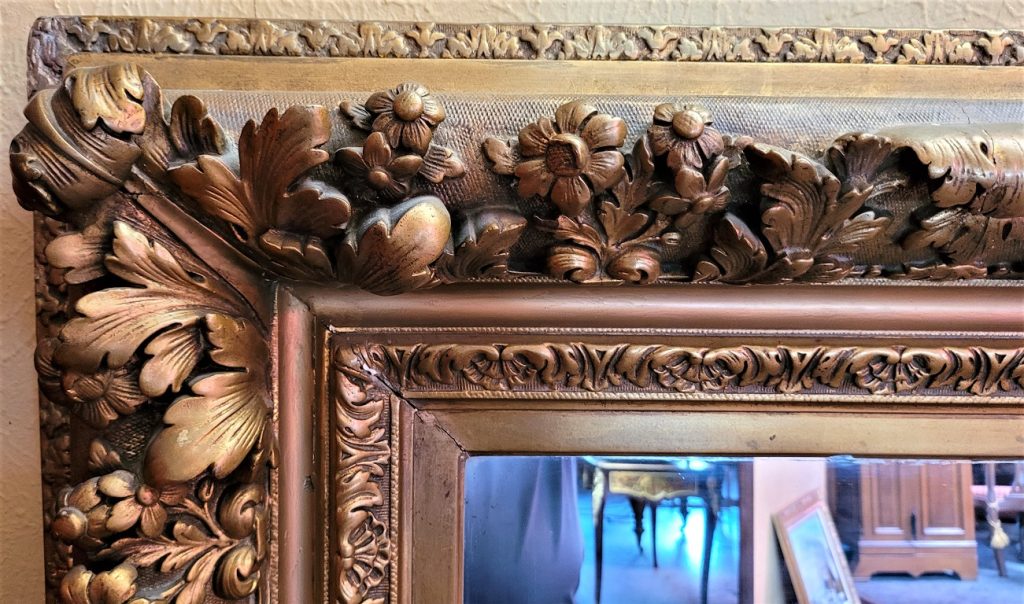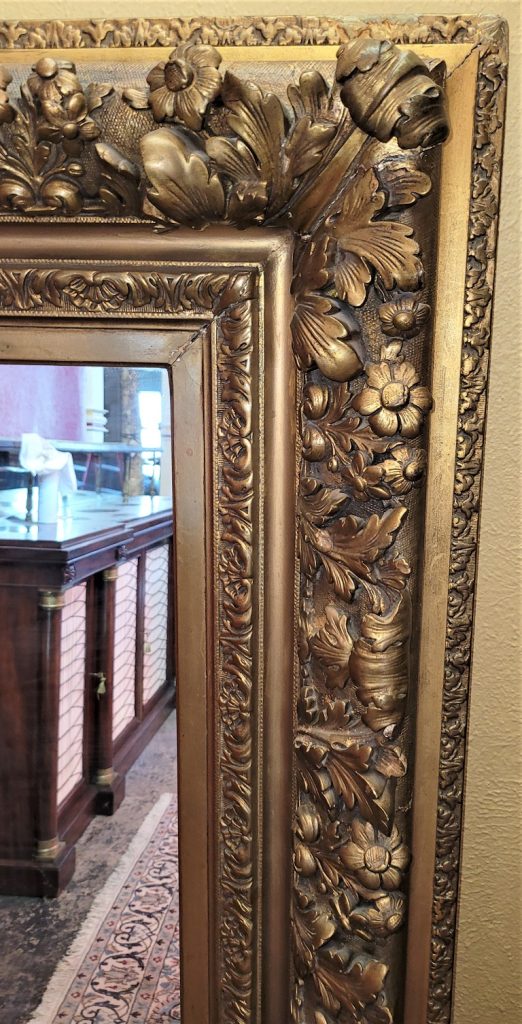Early 19C Large English Baroque Gilt Floral Wall Mirror
PRESENTING AN OUTSTANDING AND MONUMENTAL Early 19C Large English Baroque Gilt Floral Wall Mirror.
English, circa 1810-20.
In classic ‘Baroque’ style with scrolling acanthus and vines in very ornate design and detail. Made of giltwood, pine, oak and gesso.
Early mirror, as is evidenced from the natural aging to the rear.
Very large in size, hence, the ‘monumental’ description !
58 inches tall and 49.25 inches wide and 5.75 inches deep. Very heavy being over 200 lbs.
This is a very high quality and very rare, period mirror, in great condition for it’s age.
The beveled mirror glass is probably a late 20C replacement, as unlike the frame, it does not have the signs of age with pithing to the mirror backing that one would expect with a period mirror. Also, the rear cardboard backing indicates a later replacement. This is not unusual, as these are functional pieces and the clarity of the mirror glass is important for daily use. Almost every period mirror has it’s glass replaced.
.
The Baroque (UK: /bəˈrɒk/, US: /bəˈroʊk/; French: [baʁɔk]) is a style of architecture, music, dance, painting, sculpture, poetry, and other arts that flourished in Europe from the early 17th century until the 1750s. In the territories of the Spanish and Portuguese empires including the Iberian Peninsula it continued, together with new styles, until the first decade of the 19th century. It followed Renaissance art and Mannerism and preceded the Rococo (in the past often referred to as “late Baroque”) and Neoclassical styles. It was encouraged by the Catholic Church as a means to counter the simplicity and austerity of Protestant architecture, art, and music, though Lutheran Baroque art developed in parts of Europe as well.
The Baroque style used contrast, movement, exuberant detail, deep colour, grandeur, and surprise to achieve a sense of awe. The style began at the start of the 17th century in Rome, then spread rapidly to France, northern Italy, Spain, and Portugal, then to Austria, southern Germany, and Russia. By the 1730s, it had evolved into an even more flamboyant style, called rocaille or Rococo, which appeared in France and Central Europe until the mid to late 18th century.
In the decorative arts, the style employs plentiful and intricate ornamentation. The departure from Renaissance classicism has its own ways in each country. But a general feature is that everywhere the starting point is the ornamental elements introduced by the Renaissance. The classical repertoire is crowded, dense, overlapping, loaded, in order to provoke shock effects. New motifs introduced by Baroque are: the cartouche, trophies and weapons, baskets of fruit or flowers, and others, made in marquetry, stucco, or carved.
Link: https://en.wikipedia.org/wiki/Baroque
Early 19C Large English Baroque Gilt Floral Wall Mirror.
Provenance: From a High-end Dallas Collection.
Condition: Very good original condition. Some minor repairs on the corners/edges, but not noticeable. Mirror glass a replacement.
Dimensions: 58.25″ tall, 49.25″ wide and 5.75″ deep.
SALE PRICE NOW: $14,000
















































